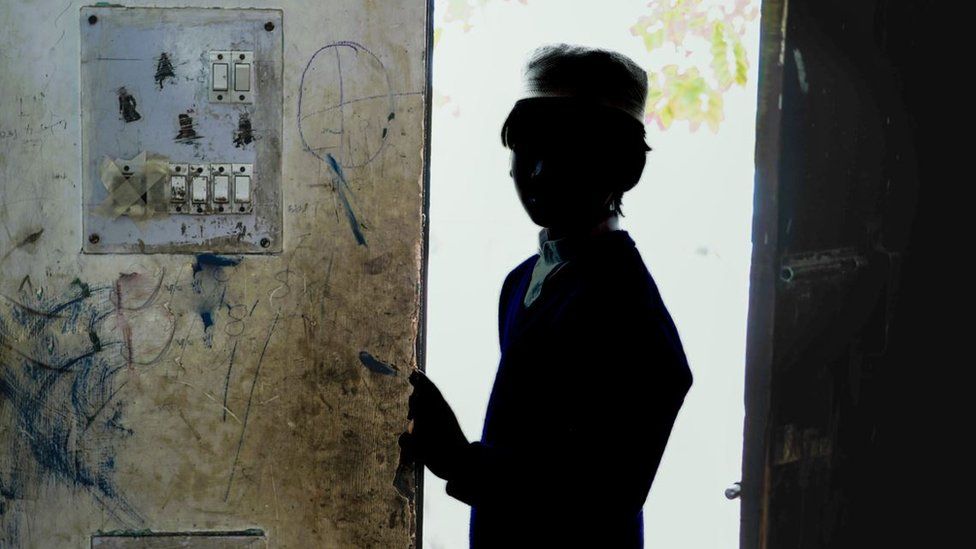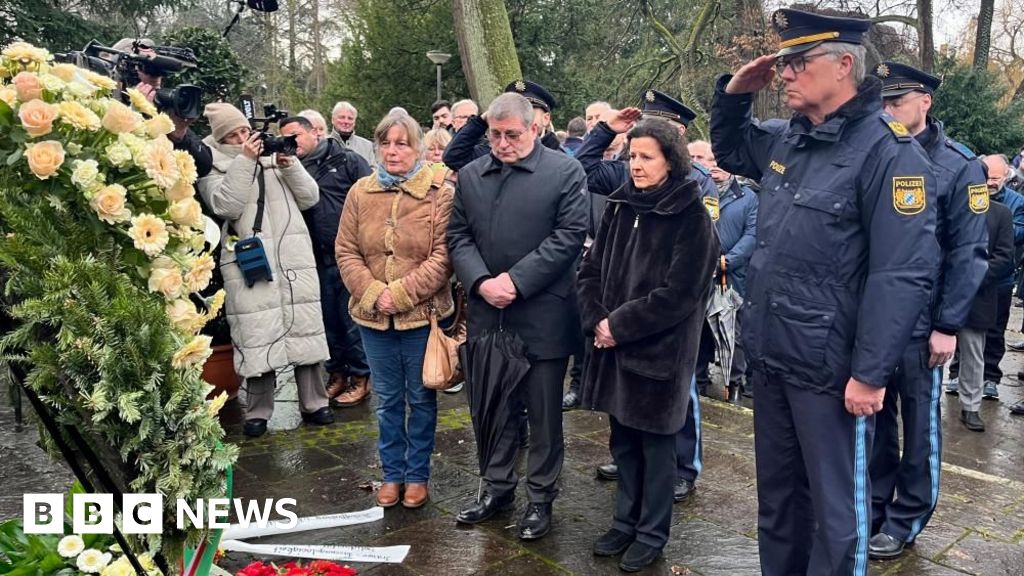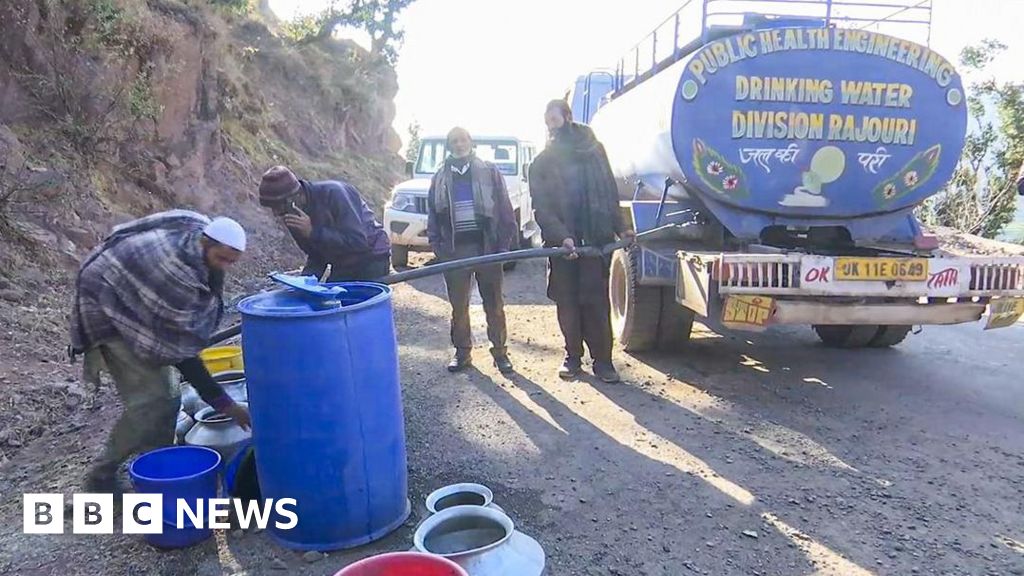ARTICLE AD BOX
 Image source, Antariksh Jain/BBC
Image source, Antariksh Jain/BBC
Around two dozen children lived in the madrassa run by the now-demolished mosque - most of them are orphans
By Zoya Mateen
BBC News, Delhi
Fawad says his favourite colour is green.
The 12-year-old loved looking at the grass, leaves and trees around the mosque where he lived and studied in India's capital Delhi. He moved here two years ago from a neighbouring state after his parents suddenly died.
His home in Delhi - the Akhoondji Mosque, estimated to be at least 600 years old, and its adjoining madrassa (religious school) - was also green, its joists, beams and several archways painted in the same colour.
In a new city, looking at the familiar colour made Fawad feel safe. But now, he says it makes him cry.
On 30 January, the Delhi Development Authority (DDA) - a federally-run urban planning organisation - bulldozed the mosque, alleging illegal encroachment. Along with it, the madrassa - where Fawad and 25 other students, mostly orphans, lived - and an adjacent graveyard and a shrine of a Sufi saint located inside the mosque complex were also razed.
Nestled in Sanjay Van, a sprawling 784-acre forest in Mehrauli, one of Delhi's seven medieval cities, the area is teeming with ruins and monuments that narrate the city's rich past.
In a statement, the DDA said the mosque was an "illegal structure" which was demolished "without any hindrance and disturbance".
But the mosque's imam Zakir Hussain and their advocate Shams Khwaja deny this, saying the property belonged to the Delhi Waqf Board, which is responsible for the maintenance of Islamic properties in the city.
Mr Hussain claims that authorities did not give them written notice before demolishing the structures. He also alleges that copies of the Quran were damaged, children were not allowed to save their belongings and that property records which proved that the mosque wasn't illegal were taken away from them.
"They left us out in the cold with nothing but prayers," Mr Hussain says.
The matter is being heard by the Delhi High Court, which on Monday ordered "a status quo" on the site until the next hearing.
Image source, Muzammil Suleman
Image caption,Fawad loved the green arches of the mosque where he lived and studied
The DDA has denied all the allegations, saying that the land on which the mosque stood was its property.
"We found some books while clearing the site and we've asked mosque authorities to collect them from us," Rajeev Kumar Tiwari, the principal commissioner of DDA's horticulture department, told the BBC.
In the days since the demolition, authorities have razed a few more historical structures in Mehrauli, including what many believe was the shrine of one of the first Sufi saints in Delhi.
Outraged preservationists and historians have called this a "mindless" destruction of collective heritage that strikes at the very soul of the city.
History dwells in most corners of Delhi, which has survived waves of conquests and change. The past co-exists with the present - you could be in a swanky neighbourhood with upscale pubs and restaurants and turn around to see a 12th Century monument or tomb wedged between the alleys.
"Delhi's incredibly rich past has contributed to its evolution as a unique city. To pitch it against progress or development is a false dichotomy," says historian Sohail Hashmi.
Critics have questioned the logic behind labelling centuries-old structures - older than the forests and habitats around them - illegal. They also allege that the planned demolitions unfairly focus on Muslim cultural and historical heritage. Among the 20 religious structures slated for removal in Sanjay Van according to the DDA, 16 are Muslim shrines ("mazaars") and four are temples.
"Clearly a pattern is emerging and it sets alarming precedent for a country that treats all religions equally," Mr Hashmi says.
But Mr Tiwari said that a "perfectly legal" move was unnecessarily being given religious overtones. He added that the DDA frequently acted against encroachments on government land, including by temples, and that it had demolished five temples in a different neighbourhood on the same day as the mosque.
"We are just doing our job," he said.
Those affected say the mosque's demolition was unannounced and chaotic. The BBC spoke to nine children who said they had woken up for morning prayers at 5am when they heard a loud rumble. One of them, Omar, remembers seeing dozens of policemen, a few bulldozers and "some angry-looking men screaming at us to come outside".
Then the imam, Mr Hussain, rushed in. "Run, run," he yelled. "Take whatever you can find and just run!"
Omar ran with just a sweater and slippers in hand. His friend Mureed couldn't even do that and went barefoot. Five other children - all 10 years old - said they ran out without jackets or shoes.
"I was lucky, at least I could bring my plate," says Zafar. "That and my favourite bat."
Image source, Muzammil Suleman
Image caption,Rubble at the site where the mosque stood for centuries
It's not just the children who are devastated. Mr Hussain, who lived in a small building near the mosque with his family, has also become homeless. He says that he visits the place every day, getting as close as he can before being stopped by police personnel guarding the site.
Muzammil Salmani, who taught English and Hindi at the madrassa, says his uncle was buried in the graveyard next to the mosque. After the demolition, all they found were some broken pieces of his grave's epitaph.
"People don't understand - this was not just an old mosque, graveyard or madrassa. It was a shelter," he says.
Not much is known about the mosque's history - some say it was built by a 13th Century princess, Razia Sultana, considered the first female Muslim leader of the Indian subcontinent. Others say it could be even older. Mr Hashmi says the use of grey stone in the structure indicates it could have been built during the Sultanate period about 600-700 years ago.
Records from the Archaeological Survey of India (ASI) show the mosque was repaired around 1853 under the last Mughal emperor Bahadur Shah Zafar. It even bore an inscription written by the emperor himself, says historian Rana Safvi.
While much of the structure underwent modern reconstruction, Ms Safvi says the mosque was still a vital part of history which deserved to be preserved. "After all, how can a mosque which was important for the last Mughal emperor be insignificant?"
The DDA, however, says it had no record of the mosque's history. "I found out after the demolition that historians are making the claim," Mr Tiwari said, adding that "the structure also looked modern and not old at all".
"We have gone out of the way to preserve monuments declared of national importance but this structure is not a part of any such record," he said.
The mosque's imam Zakir Hussain visits the site of the demolition every day - he misses his home, he says
For the people of Mehrauli, the mosque was also a social lifeline, a sanctuary and an escape, says Usama, who uses only one name.
An architect who documents the area's history in his free time, Mr Usama remembers the time he spent at the mosque celebrating festivals with the children and meeting travellers from across the country who came to pray at the mosque.
"Even though it was inside the jungle, the place was an important community centre which brought all kinds of people together. For them, its value was practical and not just historical," he says.
DDA authorities maintain the structure was razed because it was illegally constructed on precious forest land.
Sanjay Van, one of the city's last green havens, earned protected forest status in the 1990s amid rising urbanisation concerns. Lately, the DDA has initiated multiple anti-encroachment efforts in the area.
But historians point out that the mosque existed much before the forest got protected status and therefore couldn't be considered an encroachment.
They worry that such moves could threaten other structures in Mehrauli, which are badly in need of upkeep.
"There is no doubt that the forest is important. But there should be no clash between the forest and historical structures inside it; both need to be preserved," Mr Hashmi says.
The children say they miss their old home
In 2023, the DDA in its own submissions before the high court had said it would not demolish mosques, graves, and other legitimate properties owned by the Delhi Waqf Board in Mehrauli as they fell within the board's purview, and carried religious significance.
Last week, the DDA said the mosque's demolition was "approved" by a religious committee formed to look into such cases. Mosque authorities have challenged this in court, alleging that authorities overrode a 2022 court ruling that ordered DDA to identify land owned by the Waqf and demarcate it before undertaking any demolitions in the area.
Lawyer and activist Prashant Bhushan says that existing laws seem to have been arbitrarily applied in this case. "Even if DDA is invoking forest laws, they have to first determine the rights of the people living in these areas."
Mr Tiwari, however, says the land belonged to the DDA in the first place, so "such laws don't apply" in this case.
Away from the controversies, Fawad plays cricket with his friends in the courtyard of his new home at another mosque.
He doesn't hate it here, but there are fewer green facades and the place feels "new and different" without them, he says.
"But maybe I'll find a new favourite colour," he says.
Names of the children have been changed to protect their identity

 11 months ago
39
11 months ago
39








 English (US) ·
English (US) ·